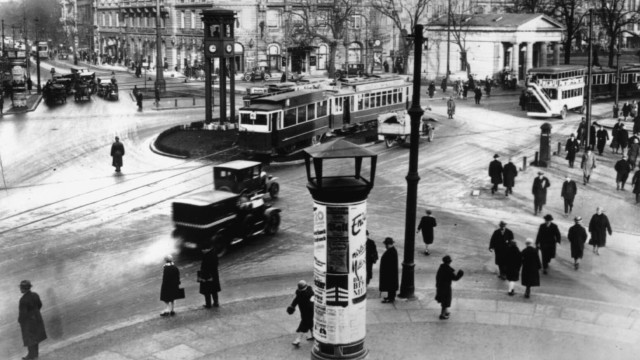
Berlin: Symphony of a Great City
Where to Watch Berlin: Symphony of a Great City

Berlin: Symphony of a Great City, directed by Walter Ruttmann in 1927, is a seminal work in the genre of city symphonies, a style of documentary filmmaking that captures the rhythm and essence of urban life through a series of evocative visuals and an accompanying score. This silent film is a vivid portrayal of Berlin during the Weimar Republic, offering a visually stunning and immersive experience that encapsulates the vibrancy and complexity of city living at the time.
The film’s structure is less narrative-driven and more focused on an impressionistic exploration of daily life in Berlin. Ruttmann eschews traditional storytelling devices, opting instead for a montage-style presentation that reflects the cacophony and the harmony of the city. Viewers are invited to witness the various aspects of urban existence, from the bustling streets filled with pedestrians and vehicles to the serene quiet moments of individuals caught in their own worlds.
The opening sequences set the tone by introducing the city in a rhythmic, almost musical sequence. The camera glides through the streets, capturing pedestrians rushing about their business, streetcars clattering along their tracks, and the ever-present hustle of commercial activities. Ruttmann uses innovative techniques, such as time-lapse photography and fast cuts, to convey a dynamic and fast-paced environment, immersing the audience in the frenetic energy that defines urban life.
As the film unfolds, it transitions through different parts of the day, depicting morning rituals of the citizens, the lively atmosphere of cafes and markets, and the industrial heartbeat of factories and warehouses. Through these snapshots of daily life, Ruttmann paints a comprehensive portrait of Berlin, showcasing not just the architectural beauty of the city but also the social fabric and diverse demographics that populate it. The film captures a wide array of social classes, from the working-class laborers to the bohemian artists, reflecting the cultural vibrancy and the contrasts present in early 20th-century urban society.
The use of intertitles is minimal, as the aim is to communicate primarily through visual storytelling, allowing the audience to feel the rhythm and flow of the city without relying heavily on textual exposition. The absence of a conventional narrative forces viewers to engage with the film on a more sensory level, interpreting the images and sounds as an emotional journey rather than a straightforward storyline. This technique encourages a personal connection to the film, allowing for different interpretations based on individual experiences and senses.
The musical score, composed by Paul Hindemith, further enriches the experience, providing an auditory backdrop that complements the visual imagery. The music is synchronized with the imagery in a way that amplifies the emotional tone of each scene—quickening during moments of hustle and gradually softening to match more introspective shots. Hindemith's composition is an integral aspect of the film, creating a symbiotic relationship between sound and vision that enhances the overall impact of the work.
Berlin: Symphony of a Great City is also notable for its historical context. Released shortly before the rise of the Nazi regime, the film captures Berlin at a moment of cultural blossoming and social change. It embodies the optimism and dynamism of the Weimar Republic while subtly hinting at the underlying tensions and challenges that would soon define Germany's tumultuous future.
Another thematic layer of the film is its exploration of modernity and technological advancement. Ruttmann showcases the industrial power of Berlin, featuring factories, cranes, and machinery that symbolize the progress and innovations of the era. This fascination with modern technology is juxtaposed with traditional elements of life, portraying a city in flux and highlighting the contrasts between the old and the new.
The cinematography, characterized by its innovative angles and movement, contributes significantly to the film’s unique aesthetic. Ruttmann’s use of depth and perspective invites the viewer’s eye to wander, capturing moments of connection and solitude amidst the urban chaos. The visual language elevates ordinary life into art, inviting the audience to find beauty in the mundane.
Berlin: Symphony of a Great City remains a cornerstone of cinematic history for its innovative approach to documentary filmmaking and its lyrical portrayal of urban life. The film transcends its era, continuing to resonate with audiences as it captures the timeless rhythms of city life and the rich tapestry of human experience within it. Its influence can be seen in countless works that followed, affirming its status as a pivotal achievement in both film and cultural representation. As a study of a great city, it offers an evocative reflection on human connection and the ever-evolving landscape of urban existence.
Berlin: Symphony of a Great City is a Documentary movie released in 1927. It has a runtime of 65 min. Critics and viewers have rated it mostly positive reviews, with an IMDb score of 7.6..
How to Watch Berlin: Symphony of a Great City
Where can I stream Berlin: Symphony of a Great City movie online? Berlin: Symphony of a Great City is available to watch and stream, buy on demand, download at Prime Video, Hulu Plus, Max, Amazon, Kanopy. Some platforms allow you to rent Berlin: Symphony of a Great City for a limited time or purchase the movie for downloading.
